Fabrication of Ni–Co–P Alloy Coatings Using Jet Electrodeposition with Varying Reciprocating Sweep Speeds and Jet Gaps to Improve Wear and Seawater Corrosion Resistance
Abstract
:1. Introduction
2. Experimental
2.1. Experimental Setup
2.2. Materials and Pretreatment
2.3. Synthesis of Ni–Co–P Alloy Coatings
2.4. Sample Characterization
3. Results and Discussion
3.1. Effects of Varying Reciprocating Sweep Speed and Jet Gap on Ni–Co–P Alloy Coating’s Cross-Section Morphologies
3.2. Effect of Varying Reciprocating Sweep Speed and Jet Gap on the EDS Patterns of Ni–Co–P Alloy Coatings
3.3. Effect of Varying Reciprocating Sweep Speed and Jet Gap on Ni–Co–P Alloy Coating XRD Patterns
3.4. Effect of Varying Reciprocating Sweep Speed and Jet Gap on the Microhardness of Ni–Co–P Alloy Coatings
3.5. Effect of Varying Reciprocating Sweep Speed and Jet Gap on the Friction resistance of Ni–Co–P Alloy Coatings
3.6. Effect of Varying Reciprocating Sweep Speed and Jet Gap on Ni–Co–P Alloy Coatings’ Seawater Corrosion Resistance
3.6.1. Influence of Reciprocating Sweep Speed Variation on Ni–Co–P Alloy Coatings’ Seawater Corrosion Resistance
3.6.2. Influence of Jet Gap Variation on Ni–Co–P Alloy Coatings’ Seawater Corrosion Resistance
4. Conclusions
- (1)
- The chemical composition, thickness, and cross-section morphologies of Ni–Co–P alloy coatings were affected by reciprocating sweep speed and jet gap. When the reciprocating sweep speed was 175 mm·s−1 and the jet gap was 2.0 mm, the contents of Co elements in the deposit attained the highest content of 47.66 wt.%. Variation of reciprocating sweep speed and jet gap exhibited no distinct influence on either peak intensities or phase structure of Ni–Co–P coatings, but a distinct preferred orientation in the (111) plane was evident.
- (2)
- Further increase in reciprocating sweep speed and jet gap caused an initial increase in the microhardness followed by a decrease, with the highest microhardness attained being 635 HV0.1. The wear track width of Ni–Co–P alloy coatings attained the narrowest width of 460 µm at a jet gap of 2.0 mm and a reciprocating sweep speed of 175 mm·s−1.
- (3)
- Ni–Co–P alloy coatings’ seawater corrosion resistance exhibited an observable change with increased reciprocating sweep speed and jet gap. The polarization curve in the electrochemical test showed that the coatings exhibited the highest polarization resistance (Rp) of 28.32 kΩ·cm−2 when the reciprocating sweep speed was 175 mm·s−1 and the jet gap was 2.0 mm, which indicated that the Ni–Co–P alloy coatings deposited under these conditions had the best seawater corrosion resistance.
Author Contributions
Funding
Acknowledgments
Conflicts of Interest
References
- Mbugua, N.S.; Kang, M.; Zhang, Y.; Ndumia, J.N.; Gbenontin, V.B.; Yao, L. Electrochemical deposition of Ni, NiCo alloy and NiCo–ceramic composite coatings—A critical review. Materials 2020, 13, 3475. [Google Scholar] [CrossRef] [PubMed]
- Schlesinger, M.; Paunovic, M. Modern Electroplating; John Wiley & Sons: New York, NY, USA, 2011. [Google Scholar]
- Nyambura, S.M.; Kang, M.; Zhu, J.; Liu, Y.; Zhang, Y.; Ndumia, J.N. Synthesis and characterization of Ni-W/Cr2O3 nanocomposite coatings using electrochemical deposition technique. Coatings 2019, 9, 815. [Google Scholar] [CrossRef] [Green Version]
- Liu, X.; Zhao, X.; An, Y.; Hou, G.; Li, S.; Deng, W.; Zhou, H.; Chen, J. Effects of loads on corrosion-wear synergism of NiCoCrAlYTa coating in artificial seawater. Tribol. Int. 2018, 118, 421–431. [Google Scholar] [CrossRef]
- Zhao, D.; Xu, X.; Xu, B. Corrosion behavior of Ni-Zn-P alloy coating in artificial seawater. Surf. Technol. 2016, 4, 169–174. (In Chinese) [Google Scholar]
- Fang, X.; Du, X.; Gao, S.; Zhang, X. Effect of artificial seawater temperature on electrochemical behavior of Ni-P and Ni-Cu-P alloy coatings. Trans. Nonferr. Met. Soc. China. 2018, 6, 1176–1181. (In Chinese) [Google Scholar]
- Wang, H.; Wu, Q.; Zhang, Z.; Yao, S.; Zhang, W. Corrosion behavior and mechanism of Ni-Sn-P alloy coatings in artificial sea water. CIESC J. 2013, 4, 1359–1363. (In Chinese) [Google Scholar]
- Pang, J.; Li, Q.; Wang, W.; Xu, X.; Zhai, J. Preparation and characterization of electroless Ni-Co-P ternary alloy on fly ash cenospheres. Surf. Coat. Technol. 2011, 205, 4237–4242. [Google Scholar] [CrossRef]
- Fetohi, A.E.; Hameed, R.M.A.; El-Khatib, K.M.; Souaya, E.R. Ni-P and Ni-Co-P coated aluminum alloy 5251 substrates as metallic bipolar plates for PEM fuel cell applications. Int. J. Hydrog. Energy 2012, 37, 7677–7688. [Google Scholar] [CrossRef]
- Khan, M.R.; Nicholson, E.L. Magnetic properties and microstructure of electroless plated Co-Ni-P and Co-P thin films for longitudinal recording. J. Magn. Magn. Mater. 1986, 54, 1654–1656. [Google Scholar] [CrossRef]
- Lew, K.S.; Raja, M.; Thanikaikarasan, S.; Kim, T.; Kim, Y.D.; Mahalingam, T. Effect of pH and current density in electrodeposited Co-Ni-P alloy thin films. Mater. Chem. Phys. 2008, 112, 249–253. [Google Scholar] [CrossRef]
- Shen, L.; Wang, Y.; Jiang, W.; Liu, X.; Wang, C.; Tian, Z. Jet electrodeposition multilayer nickel on the surface of sintered NdFeB and corrosion behaviors. Corros. Eng. Sci. Technol. 2017, 52, 311–316. [Google Scholar] [CrossRef]
- Rajput, M.S.; Pandey, P.M.; Jha, S. Micromanufacturing by selective jet electrodeposition process. Int. J. Adv. Manuf. Technol. 2015, 76, 61–67. [Google Scholar] [CrossRef]
- Qiao, G.; Jing, T.; Wang, N.; Gao, Y.; Zhao, X.; Zhou, J.; Wang, W. High-speed jet electrodeposition and microstructure of nanocrystalline Ni-Co alloys. Electrochim. Acta 2005, 51, 85–92. [Google Scholar] [CrossRef]
- Rajput, M.S.; Pandey, P.M.; Jha, S. Experimental investigations into ultrasonic-assisted jet electrodeposition process. J. Eng. Manuf. 2014, 228, 682–694. [Google Scholar] [CrossRef]
- Wang, G.F.; Shen, L.D.; Huang, Y.H. Jet electrodeposition of bulk nanocrystalline nickel with real-time polishing. Int. J. Electrochem. Sci. 2012, 7, 10818–10824. [Google Scholar]
- Zheng, X.; Wang, M.; Song, H.; Wu, D.; Liu, X.; Tan, J. Effect of ultrasonic power and pulse-on time on the particle content and mechanical property of Co-Cr3C2 composite coatings by jet electrodeposition. Surf. Coat. Technol. 2017, 325, 181–189. [Google Scholar] [CrossRef]
- Tang, Z.; Ye, X.; Tan, J.; Zhang, Q. Effect of flow of bath on properties of Co-Ni alloy coating prepared by jet electrodeposition. Electroplat. Pollut. Control 2020, 3, 11–14. [Google Scholar]
- Wang, M.; Tan, J.; Wu, D.; Lan, L. Process optimization of preparing Co-Cr3C2 composite coatings by jet-electrodeposition. China Surf. Eng. 2016, 4, 75–85. [Google Scholar]
- Zhang, Q.; Tan, J.; Xie, F.; Lan, L.; Meng, L.; Zang, Y.; Zhu, X. Effect of jet electrodeposition current density on microstructure and properties of Co-Ni-nano Cr3C2 composite coatings. Surf. Technol. 2020, 5, 191–199. [Google Scholar]
- Cui, W.; Wang, K.; Xia, F.; Wang, P. Simulation and characterization of Ni–doped SiC nanocoatings prepared by jet electrodeposition. Ceram. Int. 2018, 44, 5500–5505. [Google Scholar] [CrossRef]
- Jiang, W.; Shen, L.; Qiu, M.; Wang, X.; Fan, M.; Tian, Z. Preparation of Ni-SiC composite coatings by magnetic field-enhanced jet electrodeposition. J. Alloys Compd. 2018, 762, 115–124. [Google Scholar] [CrossRef]
- Ning, D.; Yang, C.; Wu, H. Ultrafast Cu2+ recovery from waste water by jet electrodeposition. Sep. Purif. Technol. 2019, 220, 217–221. [Google Scholar] [CrossRef]
- Kim, H.; Kim, J.G.; Park, J.W.; Chu, C.N. Selective copper metallization of nonconductive materials using jet circulating electrodeposition. Precis. Eng. 2018, 51, 153–159. [Google Scholar] [CrossRef]
- Qiao, G.; Jing, T.; Mang, N.; Gao, Y.; Zhao, X.; Zhou, J.; Wang, W. Effect of current density on microstructure and properties of bulk nanocrystalline Ni-Co alloys prepared by JED. J. Electrochem. Soc. 2006, 153, C305–C308. [Google Scholar] [CrossRef]
- Parente, M.V.; Mattos, O.R.; Diaz, S.L.; De Lima-Neto, P.; Miranda, F.F. Electrochemical characterization of Ni-P and Ni-Co-P amorphous alloy deposits obtained by electrodeposition. J. Appl. Electrochem. 2001, 31, 677–683. [Google Scholar] [CrossRef]
- Yao, S.; Liu, B.; Guo, H.; Takao, S. Study of Ni-Co-P amorphous alloy electrodeposition and its properties. J. Chem. Ind. Eng. 1996, 1, 48–52. [Google Scholar]
- Li, H.; Kang, M.; Zhang, Y.; Niu, X.; Liu, C.; Jin, M. Influences of jet parameters on structure and wear resistance of Ni-Co-BN(h) nanocomposite coatings. China Surf. Eng. 2018, 2, 103–112. (In Chinese) [Google Scholar]
- Chen, H.; Liu, Z.; Shen, L.; Qiu, M.; Tian, Z.; Ge, M. Electrochemical polishing of monocrystalline silicon with specific crystallographic planes. Mater. Sci. Semicond. Process. 2017, 67, 8–13. [Google Scholar] [CrossRef]
- Zhang, Y.; Kang, M.; Yao, L.; Mbugua, N.S.; Jin, M.; Zhu, J. Study on the wear and seawater corrosion resistance of Ni-Co-P alloy coatings with jet electrodeposition in different jet voltages and temperatures of plating solution. Coatings 2020, 10, 639. [Google Scholar] [CrossRef]
- Wang, Y.; Zhang, J.; Kang, M. Experimental study on the depositing rate of jet-electrodeposition Ni-P alloy. Electromach. Mould. 2013, 1, 16–18. (In Chinese) [Google Scholar]
- Wang, M.; Du, N.; Zhao, Q.; Lu, X. Study of quick local electrodeposition by jet plating. Mater. Prot. 2006, 9, 49–50, 70, 73. (In Chinese) [Google Scholar]
- Liu, X.; Shen, L.D.; Qiu, M.B.; Tian, Z.J.; Wang, Y.H.; Zhao, K.L. Jet electrodeposition of nanocrystalline nickel assisted by controllable friction. Surf. Coat. Technol. 2016, 305, 231–240. [Google Scholar] [CrossRef]
- Li, Z.; Deng, Y.; Shen, B.; Liu, L.; Hu, W. Synthesis, characterization and microwave properties of Ni-Co-P hollow spheres. J. Alloys Compd. 2010, 491, 406–410. [Google Scholar] [CrossRef]
- Gilewicz, A.; Chmielewska, P.; Murzynski, D.; Dobruchowska, E.; Warcholinski, B. Corrosion resistance of CrN and CrCN/CrN coatings deposited using cathodic arc evaporation in Ringer’s and Hank’s solutions. Surf. Coat. Technol. 2016, 299, 7–14. [Google Scholar] [CrossRef]
- Zimmerman, A.F.; Palumbo, G.; Aust, K.T.; Erb, U. Mechanical properties of nickel silicon carbide nanocomposites. Mater. Sci. Eng. A 2002, 328, 137–146. [Google Scholar] [CrossRef]
- Li, B.; Zhang, W.; Li, D. Synthesis and properties of a novel Ni-Co and Ni-Co/ZrO2 composite coating by DC electrodeposition. J. Alloy Compd. 2020, 821, 153258. [Google Scholar] [CrossRef]
- Archard, J.F. Contact and rubbing of flat surfaces. J. Appl. Phys. 1953, 24, 981–988. [Google Scholar] [CrossRef]
- Zhang, Y.; Kang, M.; Fu, X.; Li, H.; Liu, Y. Surface structure and wear resistance of Ni-Co-P-BN(h)-Al2O3 binary nano composite coatings. Mater. Sci. Technol. 2019, 6, 55–66. [Google Scholar]
- Hu, X.; Qu, N. Enhanced corrosion resistance of nickel–cobalt/carborundum coatings formed by supergravity field-assisted electrodeposition. Thin Solid Films 2020, 700, 137923. [Google Scholar] [CrossRef]
- Sun, Y.; Huang, Y.J.; Fan, H.B.; Wang, Y.M.; Ning, Z.L.; Liu, F.Y.; Feng, D.F.; Jin, X.X.; Shen, J.; Sun, J.F.; et al. In vitro and in vivo biocompatibility of an Ag-bearing Zr-based bulk metallic glass for potential medical use. J. NonCryst. Solids 2015, 419, 82–91. [Google Scholar] [CrossRef]
- Yu, Z.; Ji, Z.; Tao, D.; Zhang, Q.; Liu, R. Research on a reversible superwetting behavior and its corrosion resistance. Appl. Surf. Sci. 2020, 517, 146145. [Google Scholar] [CrossRef]
- Wang, X.; Zhang, Y. Microstructures and corrosion resistance properties of as-cast and homogenized AlFeNiCuCr high entropy alloy. Mater. Chem. Phys. 2020, 254, 123440. [Google Scholar] [CrossRef]
- Shun, T.T.; Hung, C.H.; Lee, C.F. Formation of ordered/disordered nanoparticles in FCC high entropy alloys. J. Alloy Compd. 2010, 493, 105–109. [Google Scholar] [CrossRef]
- Kang, M.; Zhang, Y.; Li, H. Study on the performances of Ni-Co-P/BN(h) nanocomposite coatings made by jet electrodeposition. Procedia CIRP 2018, 68, 221–226. [Google Scholar] [CrossRef]
- Fan, J.; Liu, Z.; Zhai, H.; Wang, X.; Wang, Y.; Li, Y.; Zhou, X.; Wu, S.; Liu, J. Effect of Co content on the microstructure, spreadability, conductivity and corrosion resistance of Sn-0.7Cu alloy. Microelectron. Reliab. 2020, 107, 113615. [Google Scholar] [CrossRef]
- Li, B.; Zhang, W.; Huan, Y.; Zhang, W. Effect of SiC on corrosion and wear resistance of Ni-W coatings. Rare Met. Mater. Eng. 2017, 10, 381–386. [Google Scholar]
- Yu, D.; Tian, J.; Dai, J.; Wang, X. Corrosion resistance of three-layer superhydrophobic composite coating on carbon steel in seawater. Electrochim. Acta 2013, 97, 409–419. [Google Scholar] [CrossRef]
- Jayaraj, J.; Raj, A.S.; Srinivasan, A.; Ananthakumar, S.; Pillai, U.T.S.; Dhaipule, N.G.K.; Mudali, U.K. Composite magnesium phosphate coatings for improved corrosion resistance of magnesium AZ31 alloy. Corros. Sci. 2016, 113, 104–115. [Google Scholar] [CrossRef]
- Ji, X.J.; Luan, G.F.; Lyu, J.C.; Cui, L.Y.; Li, S.Q.; Zeng, R.C.; Wang, Z.L. Corrosion resistance and tunable release of ciproflfloxacin-loaded multilayers on magnesium alloy: Effects of SiO2 nanoparticles. Appl. Surf. Sci. 2020, 508, 145240. [Google Scholar] [CrossRef]
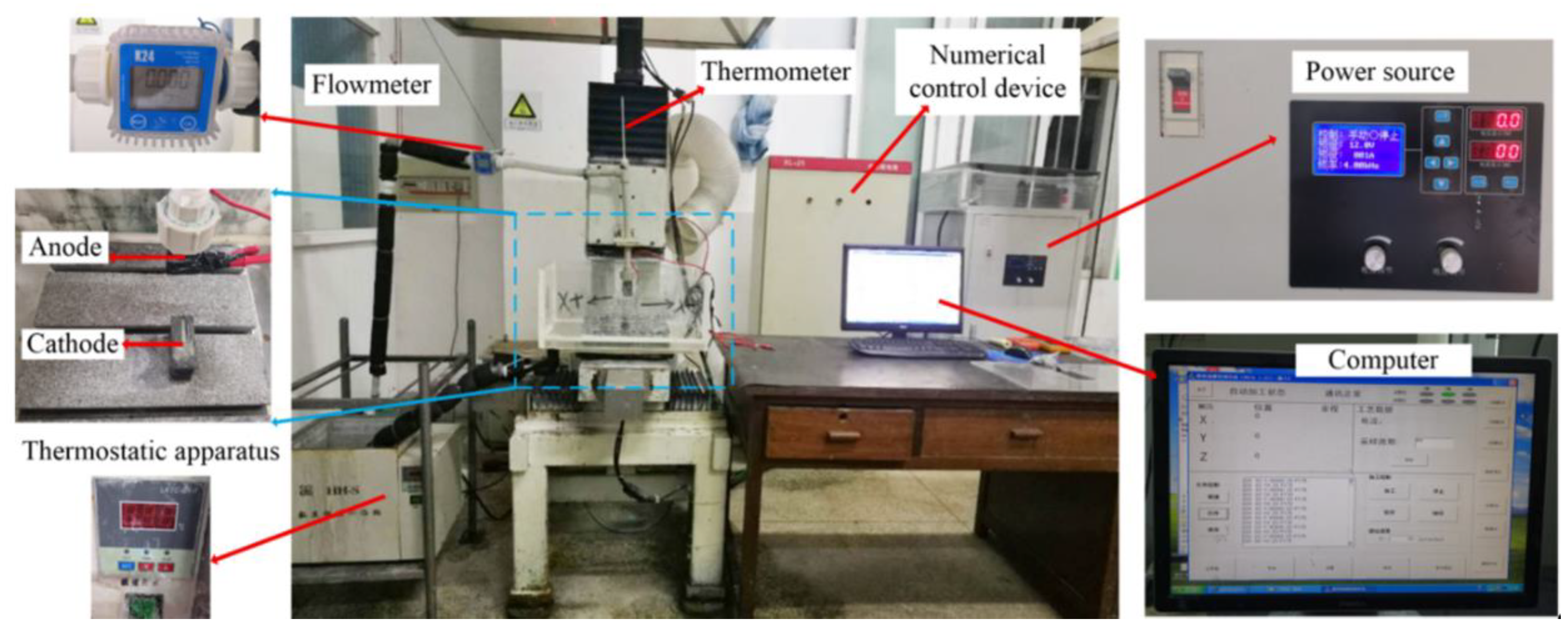
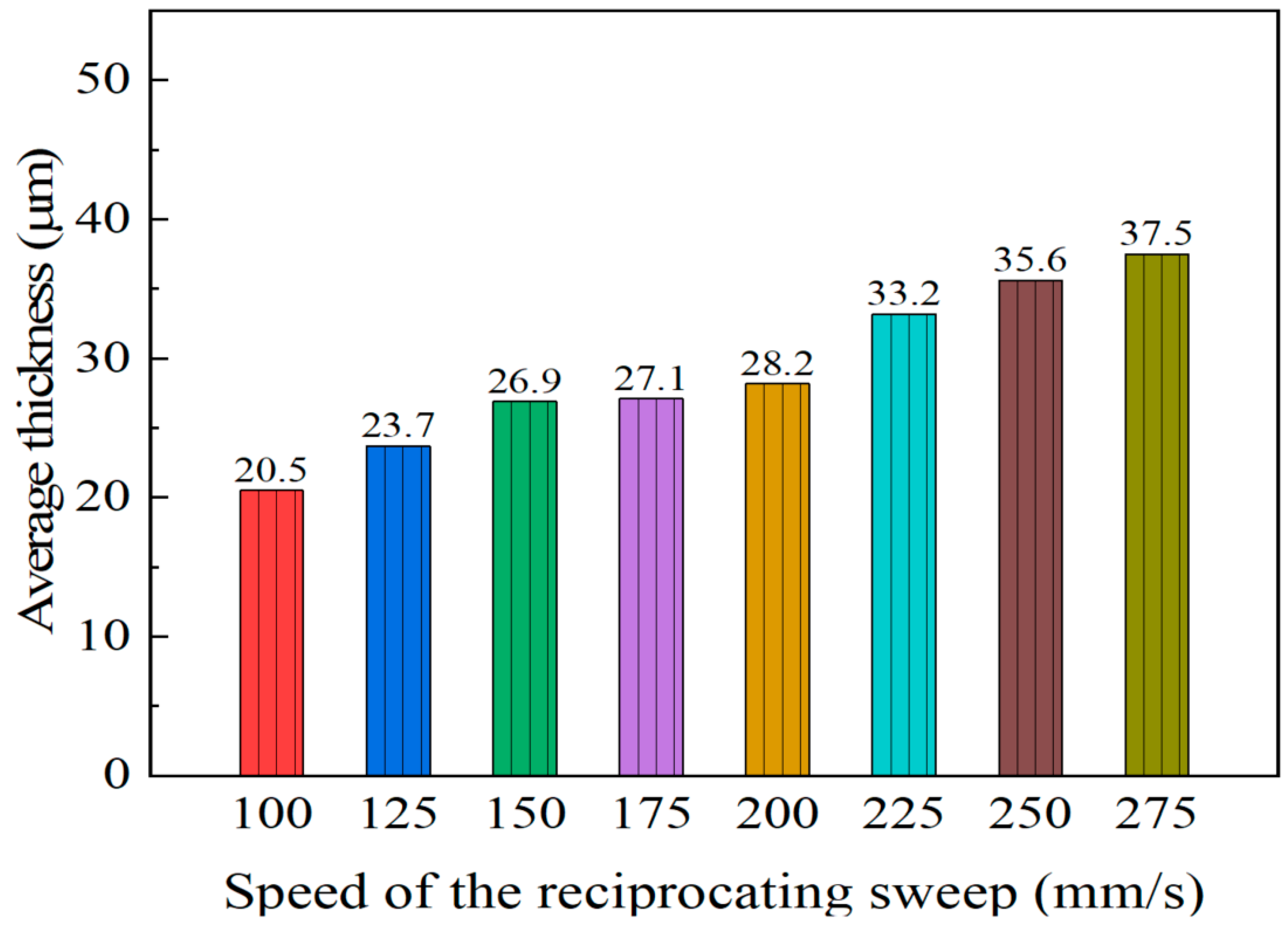

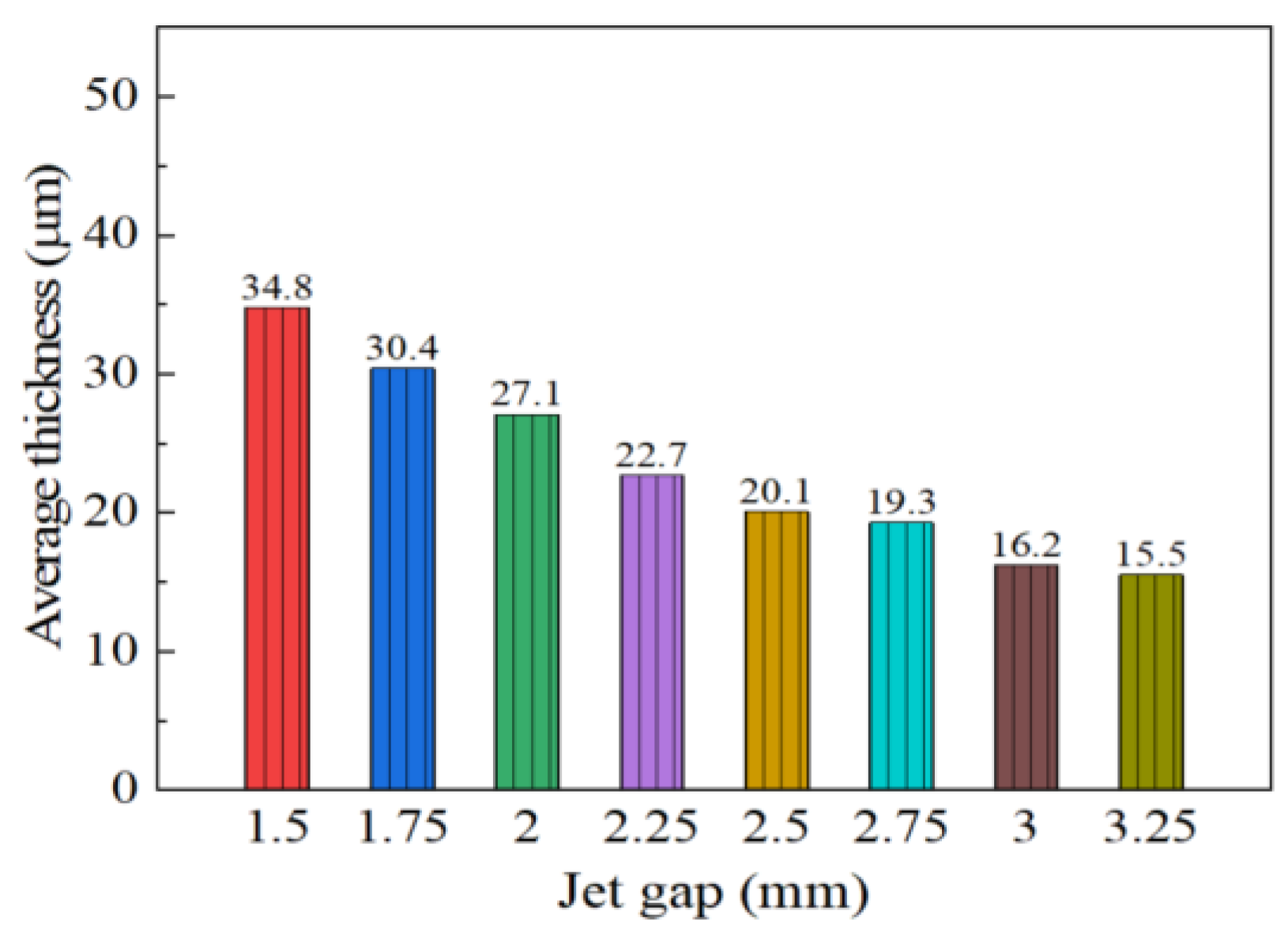


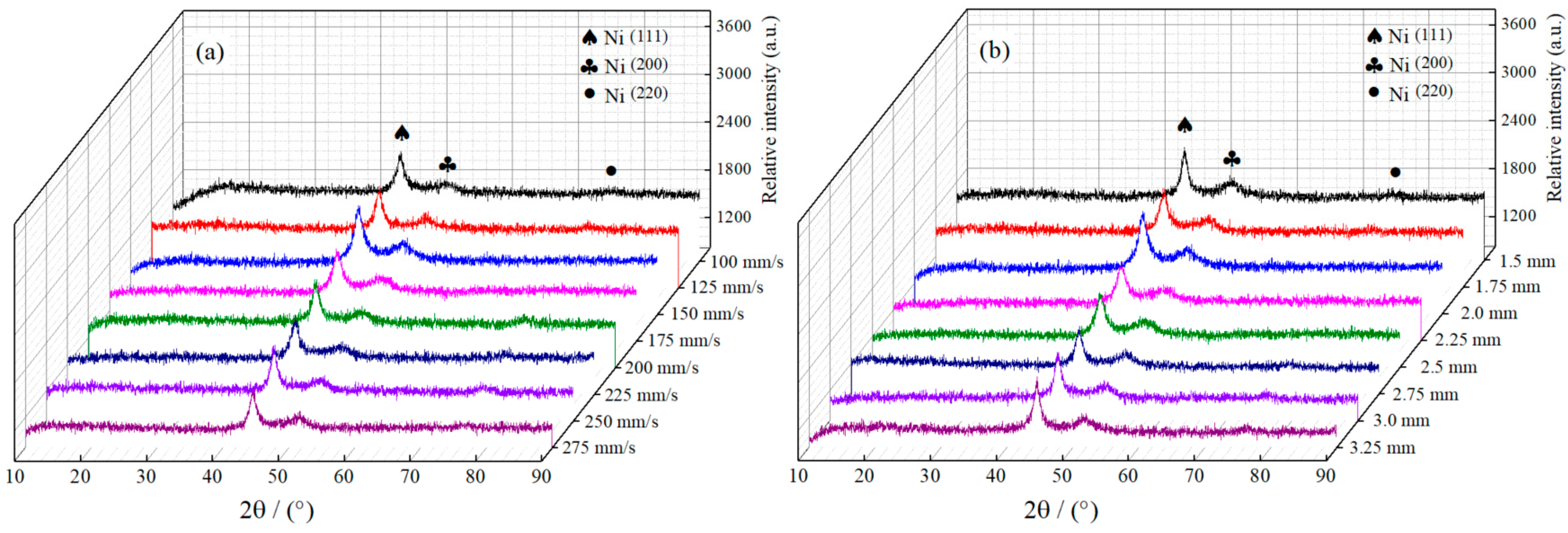

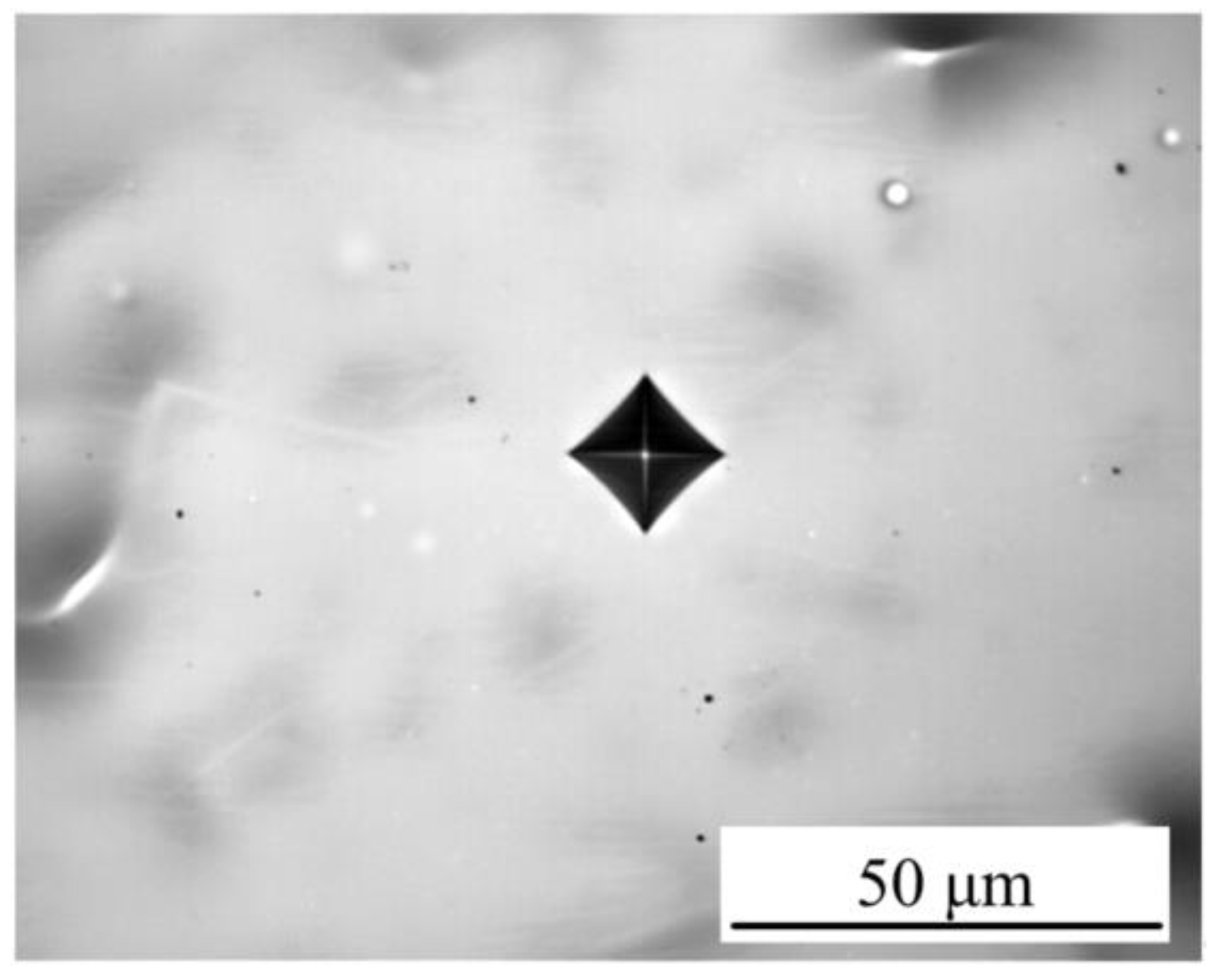

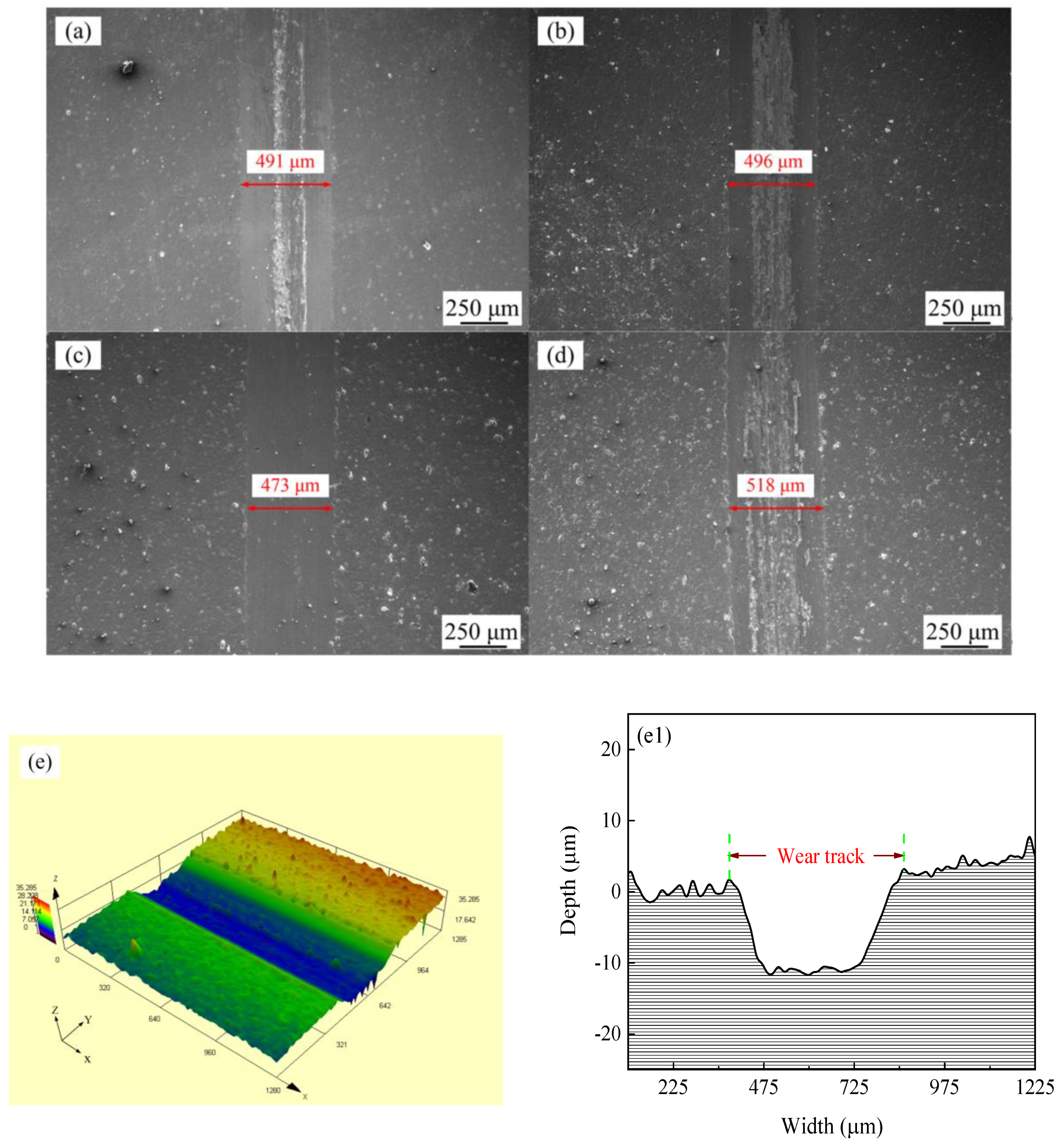
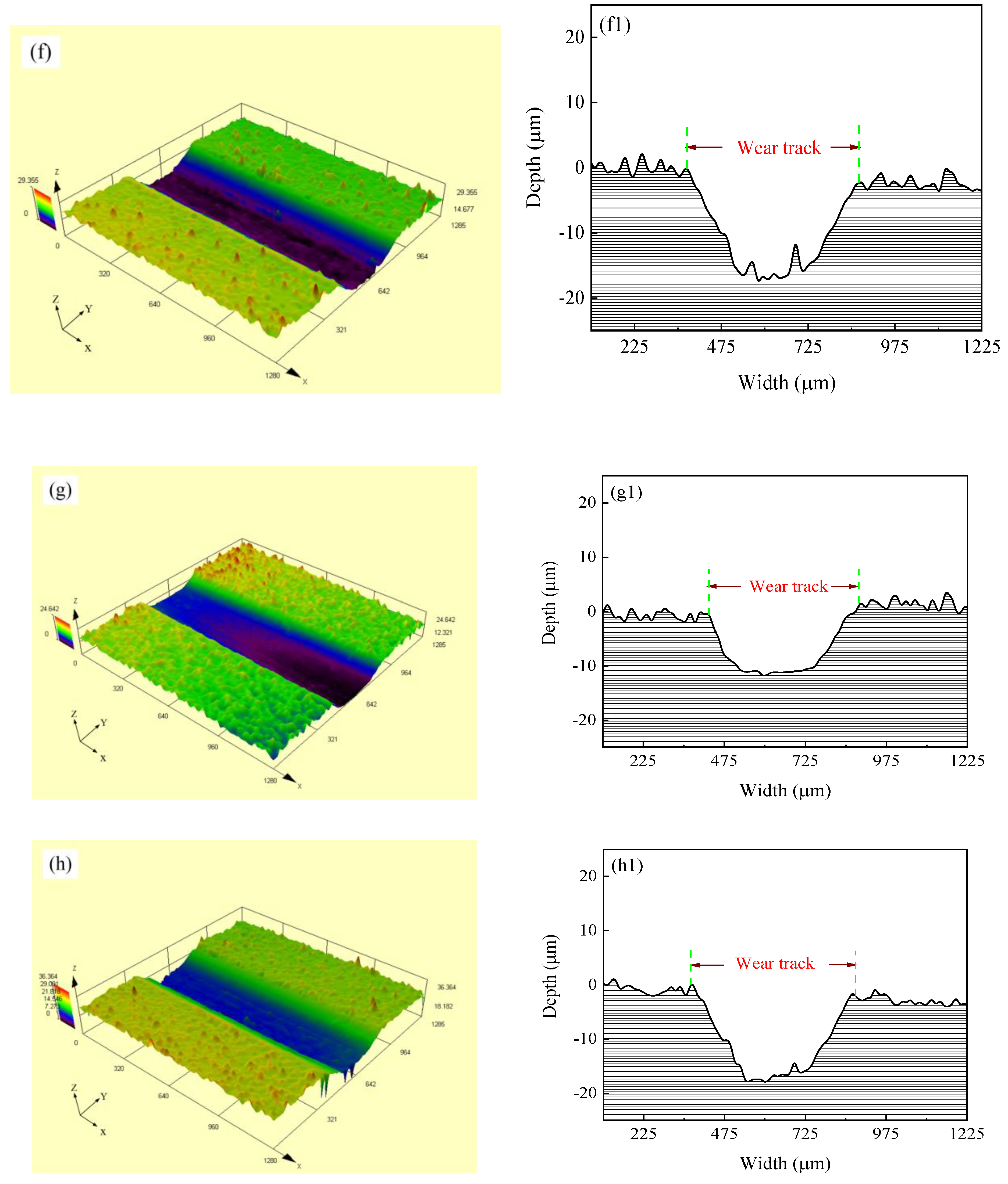

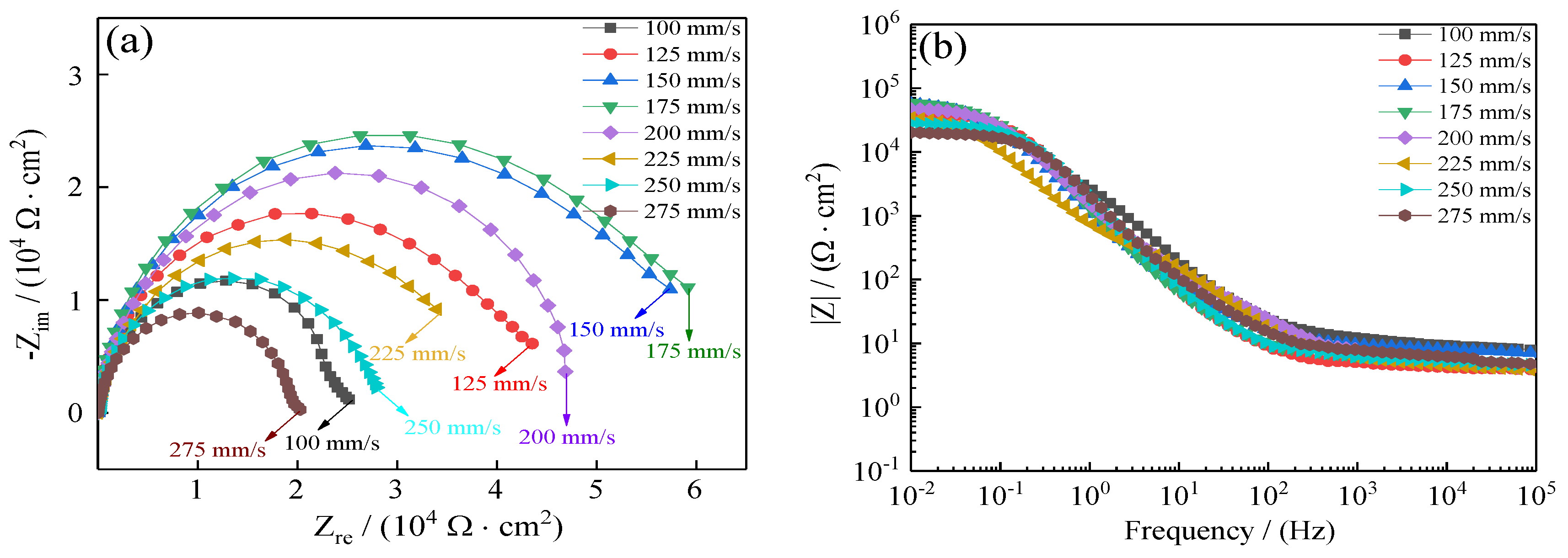

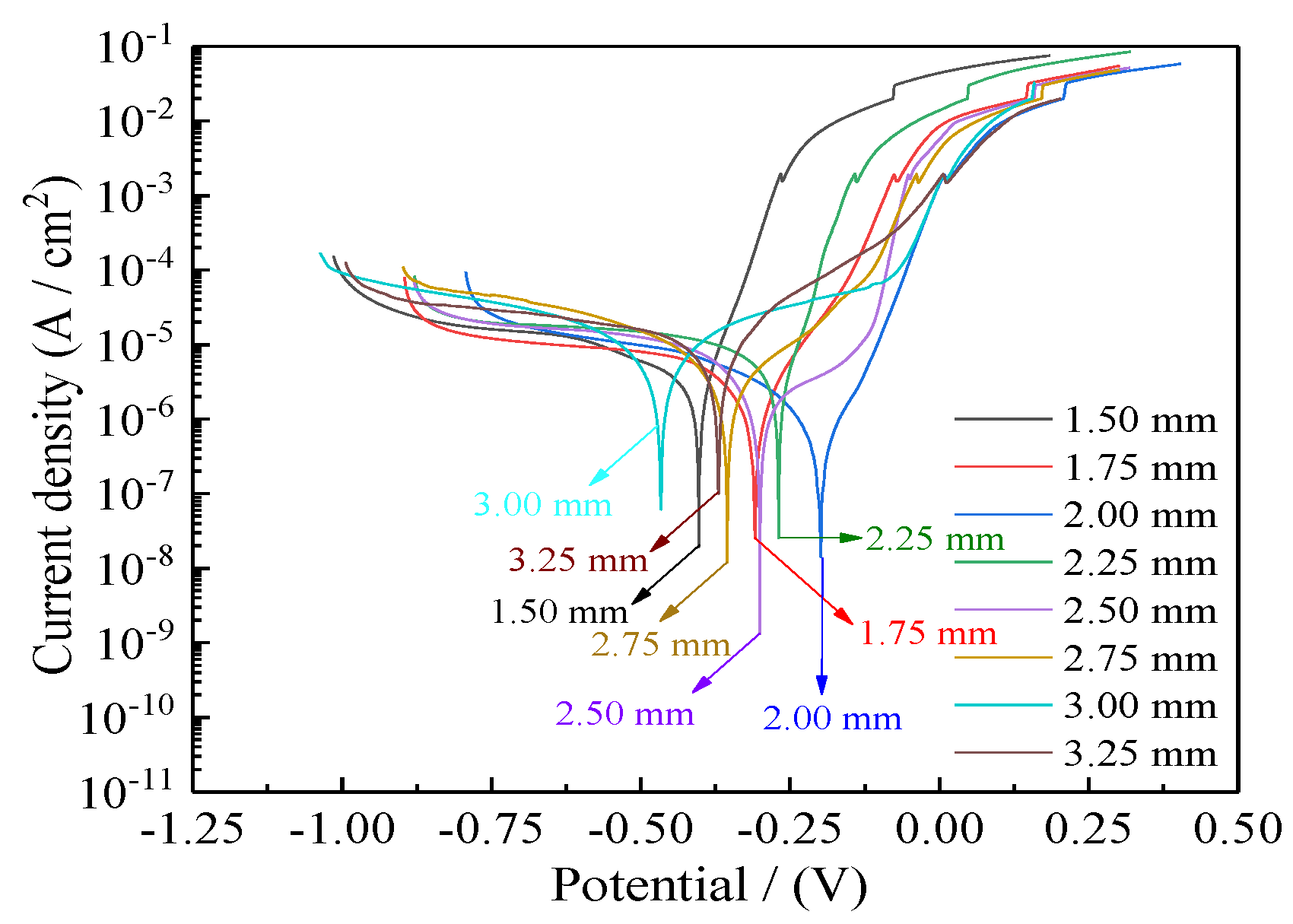
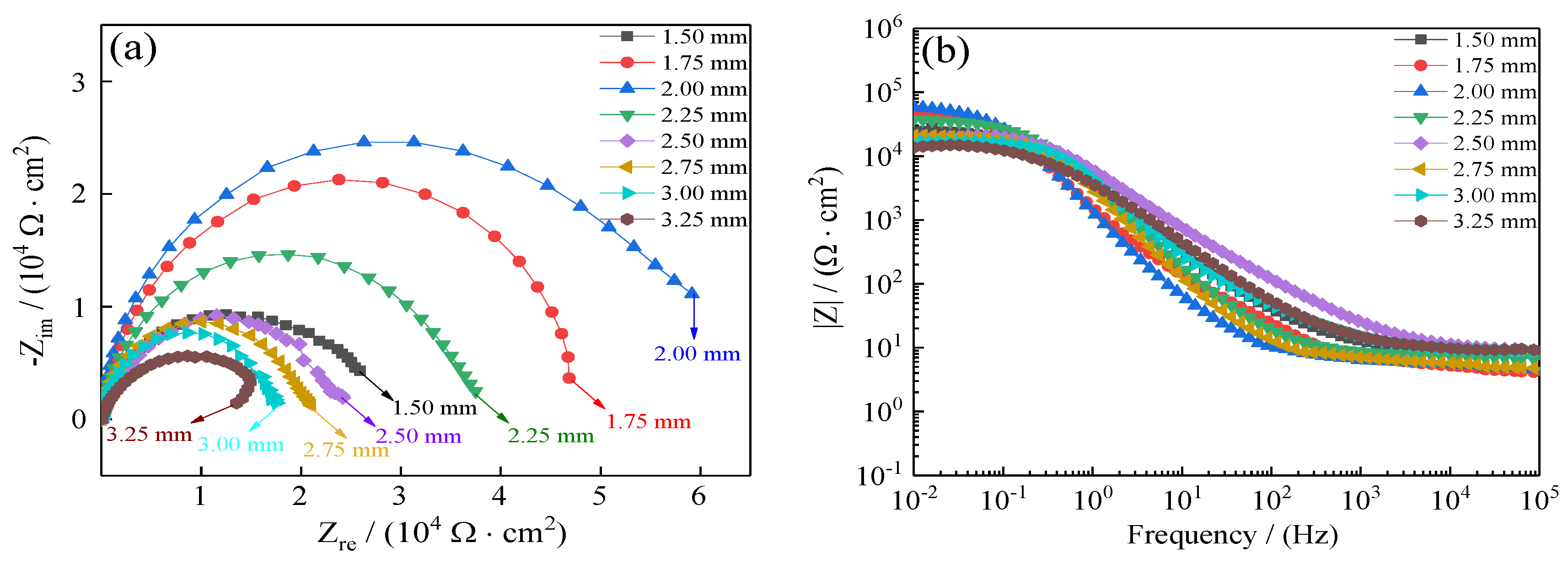
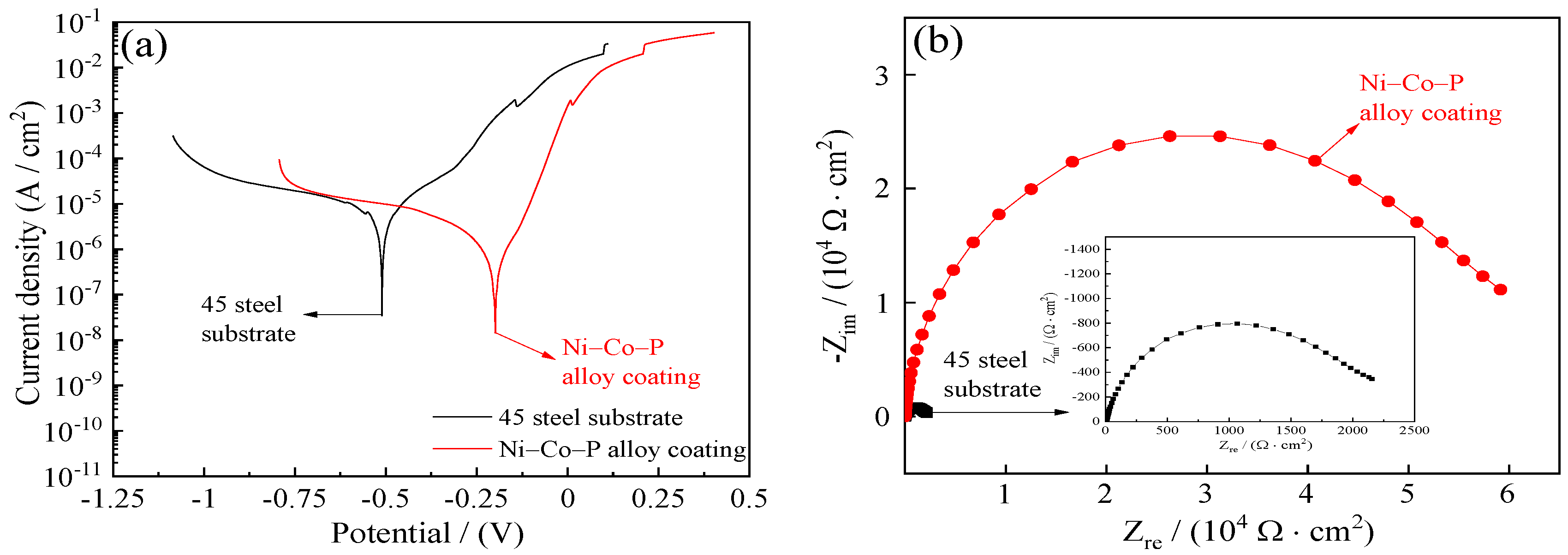
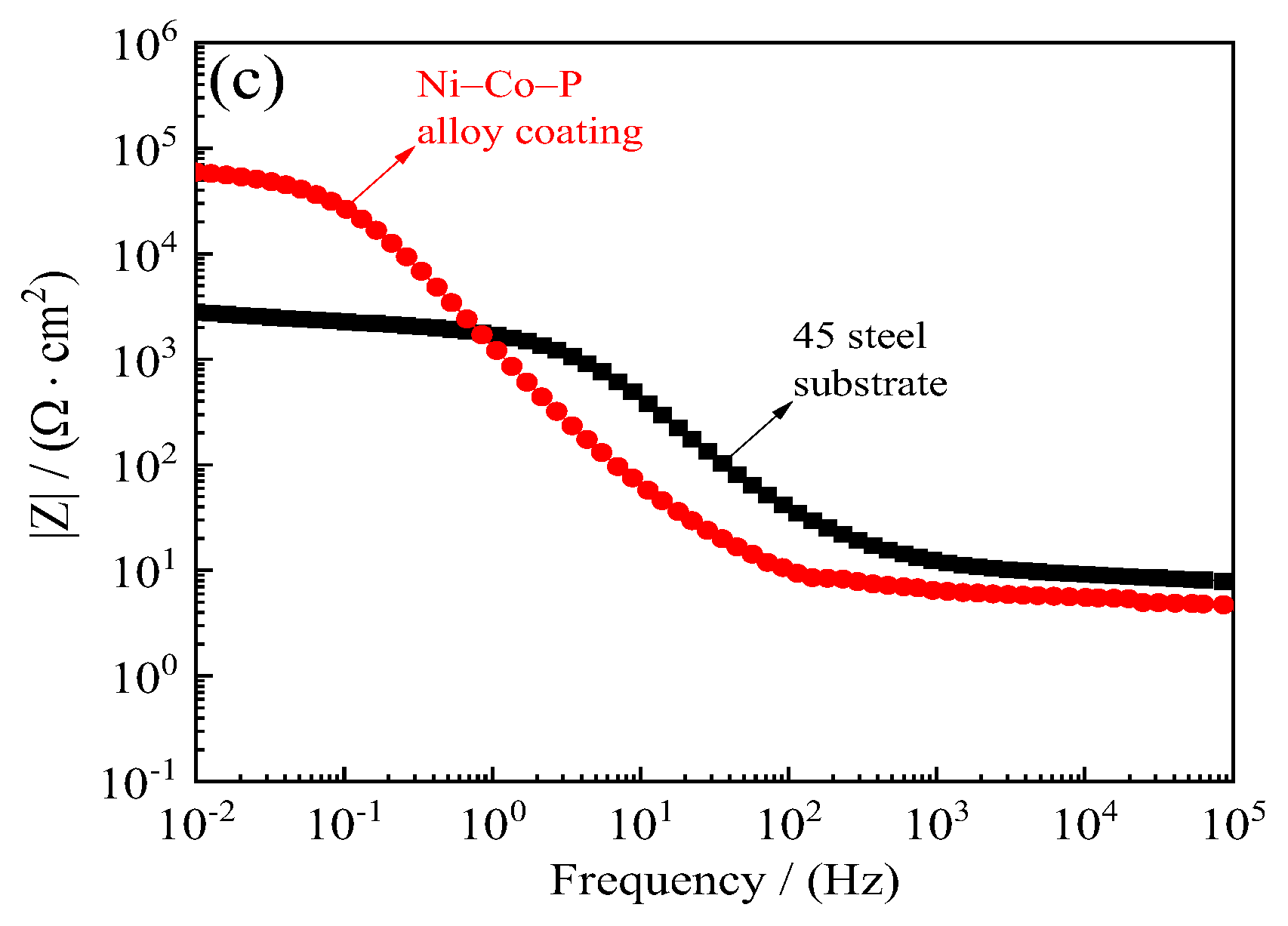
| Solution | Concentration | Operating Conditions |
|---|---|---|
| 1# Electric Cleaning/(g·L−1) | 50.0 Na3PO4 + 25.0 NaOH + 21.7 Na2CO3 + 2.4 NaCl | Processing time 25 s, |
| Treatment current 1 A | ||
| 2# Strong Activation/(g·L−1) | 140.1 NaCl + 25.0 Hydrochloric acid | Processing time 30 s, |
| Treatment current 1 A | ||
| 3# Weak Activation/(g·L−1) | 141.2 Na3C6H5O7·2H2O + 94.3 H3C6H5O7·H2O + 3.0 NiCl2·6H2O | Processing time 30 s, |
| Treatment current 1 A |
| Speed of the Reciprocating Sweep (mm/s) | Co (wt.%) | Microhardness (HV0.1) | Jet Gap/(mm) | Co (wt.%) | Microhardness (HV0.1) |
|---|---|---|---|---|---|
| 100 | 38.75 | 620 | 1.50 | 43.40 | 583 |
| 125 | 45.44 | 631 | 1.75 | 44.14 | 616 |
| 150 | 47.46 | 634 | 2.00 | 47.66 | 635 |
| 175 | 47.66 | 635 | 2.25 | 44.41 | 622 |
| 200 | 47.49 | 611 | 2.50 | 42.26 | 610 |
| 225 | 46.03 | 595 | 2.75 | 42.28 | 592 |
| 250 | 44.28 | 587 | 3.00 | 41.99 | 584 |
| 275 | 43.79 | 570 | 3.25 | 41.84 | 576 |
| Speed of the Reciprocating Sweep (mm/s) | Ecorr/(mV) | Icorr/(µA·cm−2) | Corrosion Rate/(µm·Year−1) | βa (mV/dec) | βc (mV/dec) | Rp (kΩ·cm−2) |
|---|---|---|---|---|---|---|
| 100 | −518 | 10.73 | 141.9 | 202 | 233 | 4.38 |
| 125 | −436 | 8.38 | 101.4 | 501 | 493 | 12.89 |
| 150 | −220 | 1.72 | 20.8 | 94 | 444 | 19.61 |
| 175 | −198 | 1.42 | 17.1 | 141 | 269 | 28.32 |
| 200 | −348 | 2.05 | 27.2 | 92 | 244 | 14.16 |
| 225 | −417 | 4.73 | 57.2 | 121 | 1324 | 10.19 |
| 250 | −374 | 5.07 | 61.4 | 148 | 431 | 9.44 |
| 275 | −342 | 5.82 | 70.4 | 139 | 466 | 7.99 |
| Speed of the Reciprocating Sweep (mm/s) | Rs/(Ω·cm−2) | Cc/(μF·cm−2) | Rc/(kΩ·cm−2) | Cdl/(μF·cm−2) | Rct/(104 Ω·cm−2) |
|---|---|---|---|---|---|
| 100 | 11.85 | 4.52 | 2.10 | 16.37 | 2.02 |
| 125 | 5.72 | 12.20 | 1.71 | 20.61 | 3.68 |
| 150 | 8.28 | 11.31 | 6.67 | 24.43 | 4.85 |
| 175 | 6.96 | 7.23 | 5.87 | 21.64 | 5.04 |
| 200 | 7.21 | 8.28 | 1.29 | 18.54 | 3.83 |
| 225 | 6.12 | 14.98 | 1.22 | 32.92 | 2.49 |
| 250 | 6.77 | 9.49 | 1.64 | 21.04 | 2.48 |
| 275 | 7.84 | 9.21 | 1.41 | 21.31 | 1.75 |
| Jet Gap/(mm) | Ecorr/(mV) | Icorr/(µA·cm−2) | Corrosion Rate/(µm·Year−1) | βa (mV/dec) | βc (mV/dec) | Rp (kΩ·cm−2) |
|---|---|---|---|---|---|---|
| 1.50 | −402 | 2.57 | 31.1 | 72 | 255 | 9.49 |
| 1.75 | −308 | 1.65 | 20.1 | 97 | 175 | 16.44 |
| 2.00 | −198 | 1.42 | 17.1 | 141 | 269 | 28.32 |
| 2.25 | −269 | 2.13 | 30.6 | 114 | 198 | 14.76 |
| 2.50 | −300 | 5.34 | 64.7 | 1105 | 201 | 13.84 |
| 2.75 | −355 | 6.97 | 84.3 | 393 | 292 | 10.45 |
| 3.00 | −466 | 9.16 | 110.9 | 302 | 339 | 7.58 |
| 3.25 | −369 | 12.04 | 145.7 | 173 | 581 | 4.81 |
| Jet Gap/(mm) | Rs/(Ω·cm−2) | Cc/(μF·cm−2) | Rc/(kΩ·cm−2) | Cdl/(μF·cm−2) | Rct/(104 Ω·cm−2) |
|---|---|---|---|---|---|
| 1.50 | 9.12 | 6.07 | 1.53 | 11.01 | 2.05 |
| 1.75 | 7.12 | 4.44 | 1.29 | 19.45 | 3.92 |
| 2.00 | 6.96 | 7.23 | 5.87 | 21.64 | 5.04 |
| 2.25 | 7.35 | 3.76 | 2.49 | 12.57 | 3.18 |
| 2.50 | 11.39 | 9.24 | 1.61 | 14.69 | 2.02 |
| 2.75 | 7.17 | 8.46 | 0.64 | 16.78 | 1.80 |
| 3.00 | 10.70 | 6.72 | 1.22 | 10.52 | 1.51 |
| 3.25 | 10.35 | 3.77 | 0.36 | 9.94 | 1.17 |
© 2020 by the authors. Licensee MDPI, Basel, Switzerland. This article is an open access article distributed under the terms and conditions of the Creative Commons Attribution (CC BY) license (http://creativecommons.org/licenses/by/4.0/).
Share and Cite
Zhang, Y.; Kang, M.; Nyambura, S.M.; Yao, L.; Jin, M.; Zhu, J. Fabrication of Ni–Co–P Alloy Coatings Using Jet Electrodeposition with Varying Reciprocating Sweep Speeds and Jet Gaps to Improve Wear and Seawater Corrosion Resistance. Coatings 2020, 10, 924. https://doi.org/10.3390/coatings10100924
Zhang Y, Kang M, Nyambura SM, Yao L, Jin M, Zhu J. Fabrication of Ni–Co–P Alloy Coatings Using Jet Electrodeposition with Varying Reciprocating Sweep Speeds and Jet Gaps to Improve Wear and Seawater Corrosion Resistance. Coatings. 2020; 10(10):924. https://doi.org/10.3390/coatings10100924
Chicago/Turabian StyleZhang, Yin, Min Kang, Samuel Mbugua Nyambura, Liang Yao, Meifu Jin, and Jiping Zhu. 2020. "Fabrication of Ni–Co–P Alloy Coatings Using Jet Electrodeposition with Varying Reciprocating Sweep Speeds and Jet Gaps to Improve Wear and Seawater Corrosion Resistance" Coatings 10, no. 10: 924. https://doi.org/10.3390/coatings10100924
APA StyleZhang, Y., Kang, M., Nyambura, S. M., Yao, L., Jin, M., & Zhu, J. (2020). Fabrication of Ni–Co–P Alloy Coatings Using Jet Electrodeposition with Varying Reciprocating Sweep Speeds and Jet Gaps to Improve Wear and Seawater Corrosion Resistance. Coatings, 10(10), 924. https://doi.org/10.3390/coatings10100924





